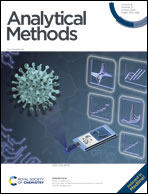Solvation effect enabled visualized discrimination of multiple metal ions†
Abstract
Highly efficient detection of environmental residual potentially toxic species is of concern worldwide as their presence in an excessive amount would greatly endanger the health of human beings as well as environmental sustainability. The solvation effect is a critical factor to be considered for understanding chemical reaction progress as well as the photophysical behaviors of substances and thus is promising for visualized detection of metal ions. Herein, by applying 5-amino-1,10-phenanthroline (APT) as the optical probe, a sensing strategy was proposed based on the solvation effect modulated complexation of APT towards different metal ions to achieve the visualized discrimination of four critical ions (Cu(II), Zn(II), Cd(II), and Al(III)). How the crucial intrinsic properties of the solvent (e.g., polarity, solvent free energy, and electrostatic potential) influenced the complexation and the product emission was clarified, and the detection performances were systematically evaluated with detection limits as low as the nM level and good recognition selectivity. Furthermore, a portable sensing chip was developed with potential for highly efficient analysis in complicated scenes; thus, this strategy offers a new insight into determining multiple metal ions or other critical substances upon solvation manipulation.



 Please wait while we load your content...
Please wait while we load your content...